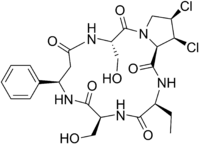Cyclochlorotine
 | |
 | |
| Names | |
|---|---|
| IUPAC name
1,2-Dichloro-15-ethyl-5,12-bis-hydroxymethyl-9-phenyl-dodecahydro-3a,6,10,13,16-pentaaza-cyclopentac
yclohexadecene-4,7,11,14,17-pentaone | |
| Other names
Cyclo[(R)-3-phenyl-β-alanyl-L-seryl-(2α,3α,4α)-3,4-dichloro-L-prolyl-L-2-aminobutanoyl-L-seryl]; Yellowed rice toxin | |
| Identifiers | |
| 12663-46-6 | |
| 3D model (Jmol) | Interactive image |
| ChemSpider | 28426727 |
| KEGG | C19379 |
| PubChem | 25565 |
| |
| |
| Properties | |
| C24H31Cl2N5O7 | |
| Molar mass | 572.44 g·mol−1 |
| Except where otherwise noted, data are given for materials in their standard state (at 25 °C [77 °F], 100 kPa). | |
| | |
| Infobox references | |
Cyclochlorotine[1] (CC) is a mycotoxin produced by the fungus Penicillium islandicum[2] that causes liver damage and has carcinogenic properties.[3] It is listed as an IARC Group 3 carcinogen.
Chemically, it is a chlorinated cyclic peptide.[4]
References
- ↑ Zhou, ZH; Komiyama, M; Terao, K; Shimada, Y (1994). "Effects of cyclochlorotine on myofibrils in cardiomyocytes and on actin filament bundles in fibroblasts in vitro". Nat. Toxins. 2 (6): 378–85. PMID 7704452.
- ↑ "Toxicology of Penicillium Islandicum". Nature. 191 (4791): 864–865. 1961. Bibcode:1961Natur.191..864.. doi:10.1038/191864b0.
- ↑ Penicillium islandicum causes hepatic necrosis and has carcinogenic properties
- ↑ Kohei Mizutani; Yusuke Hirasawa; Yoshiko Sugita-Konishi; Naoki Mochizuki; Hiroshi Morita (2008). "Structural and Conformational Analysis of Hydroxycyclochlorotine and Cyclochlorotine, Chlorinated Cyclic Peptides from Penicillium islandicum". J. Nat. Prod. 71 (7): 1297–1300. doi:10.1021/np800150m. PMID 18558744.
This article is issued from Wikipedia - version of the 5/29/2016. The text is available under the Creative Commons Attribution/Share Alike but additional terms may apply for the media files.